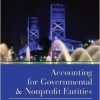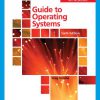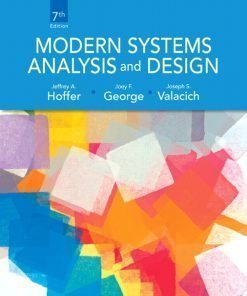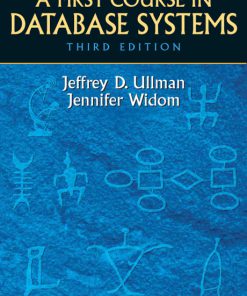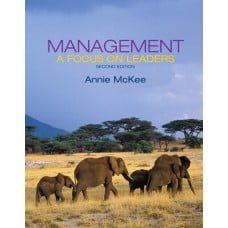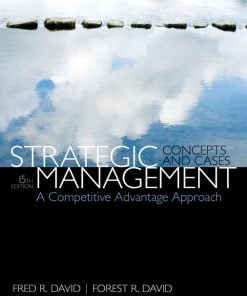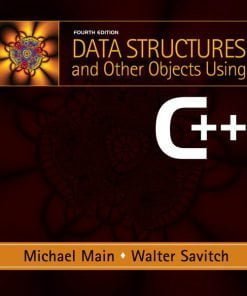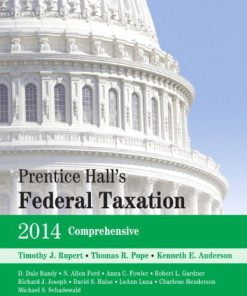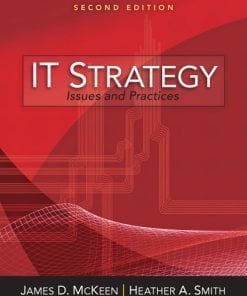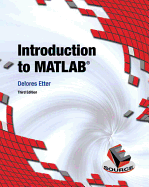Solution Manual for Engineering Economics Financial Decision Making for Engineers 5th Edition by Fraser
$35.00 Original price was: $35.00.$26.50Current price is: $26.50.
Solution Manual for Engineering Economics Financial Decision Making for Engineers 5th Edition by Fraser
Instant download Solution Manual for Engineering Economics Financial Decision Making for Engineers 5th Edition by Fraser pdf docx epub after payment.
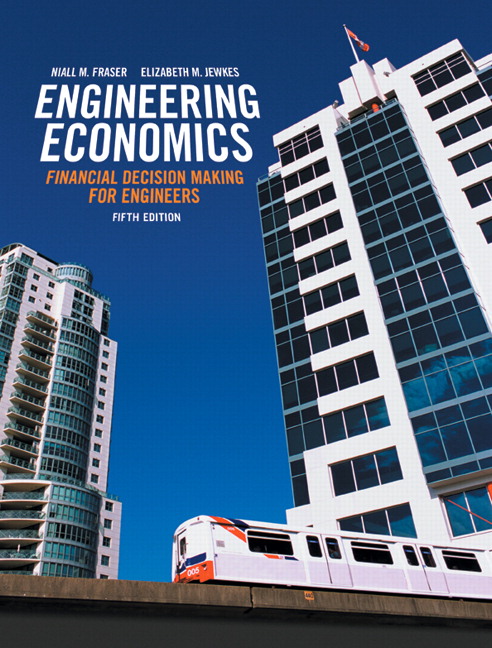
Product details:
- ISBN-10 : 0132379252
- ISBN-13 : 978-0132379250
- Author: Niall M. Fraser; Elizabeth M. Jewkes
Engineering Financial Decision Making for Engineers¿ is designed for teaching a course on engineering economics to match engineering practice today. It recognizes the role of the engineer as a decision maker who has to make and defend sensible decisions. Such decisions must not only take into account a correct assessment of costs and benefits, they must also reflect an understanding of the environment in which the decisions are made. The 5 th edition has new material on project management in order to adhere to the CEAB guidelines as well the new edition will have a new spreadsheet feature throughout the text.\
Table of contents:
- Machine generated contents note: pt. 1 UNDERSTANDING MONEY AND ITS MANAGEMENT
- ch. 1 Engineering Economic Decisions
- 1.1. The Rational Decision-Making Process
- 1.1.1. How Do We Make Typical Personal Decisions?
- 1.1.2. How Do We Approach an Engineering Design Problem?
- 1.1.3. What Makes Economic Decisions Different from Other Design Decisions?
- 1.2. The Engineer’s Role in Business
- 1.2.1. Making Capital-Expenditure Decisions
- 1.2.2. Large-Scale Engineering Economic Decisions
- 1.2.3. Impact of Engineering Projects on Financial Statements
- 1.3. Types of Strategic Engineering Economic Decisions
- 1.3.1. New Products or Product Expansion
- 1.3.2. Equipment and Process Selection
- 1.3.3. Cost Reduction
- 1.3.4. Equipment Replacement
- 1.3.5. Service or Quality Improvement
- 1.4. Fundamental Principles in Engineering Economics
- Summary
- Self-Test Questions
- Problems
- ch. 2 Time Value of Money
- 2.1. Interest: The Cost of Money
- 2.1.1. The Time Value of Money
- 2.1.2. Elements of Transactions Involving Interest
- 2.1.3. Methods of Calculating Interest
- 2.2. Economic Equivalence
- 2.2.1. Definition and Simple Calculations
- 2.2.2. Equivalence Calculations Require a Common Time Basis for Comparison
- 2.3. Interest Formulas for Single Cash Flows
- 2.3.1.Compound-Amount Factor
- 2.3.2. Present-Worth Factor
- 2.3.3. Solving for Time and Interest Rates
- 2.4. Uneven-Payment Series
- 2.5. Equal-Payment Series
- 2.5.1.Compound-Amount Factor: Find F, Given A, i, and N
- 2.5.2. Sinking-Fund Factor: Find A, Given F, i, and N
- 2.5.3. Capital-Recovery Factor (Annuity Factor): Find A, Given P, i, and N
- 2.5.4. Present-Worth Factor: Find P, Given A, i, and N
- 2.5.5. Present Value of Perpetuities
- 2.6. Dealing with Gradient Series
- 2.6.1. Handling Linear Gradient Series
- 2.6.2. Handling Geometric Gradient Series
- 2.7. More on Equivalence Calculations
- Summary
- Self-Test Questions
- Problems
- ch. 3 Understanding Money Management
- 3.1. Market Interest Rates
- 3.1.1. Nominal Interest Rates
- 3.1.2. Annual Effective Yields
- 3.2. Calculating Effective Interest Rates Based on Payment Periods
- 3.2.1. Discrete Compounding
- 3.2.2. Continuous Compounding
- 3.3. Equivalence Calculations with Effective Interest Rates
- 3.3.1.Compounding Period Equal to Payment Period
- 3.3.2.Compounding Occurs at a Different Rate than That at Which Payments are Made
- 3.4. Debt Management
- 3.4.1. Borrowing with Credit Cards
- 3.4.2.Commercial Loans
- Calculating Principal and Interest Payments
- 3.4.3.Comparing Different Financing Options
- Summary
- Self-Test Questions
- Problems
- ch. 4 Equivalence Calculations under Inflation
- 4.1. Measure of Inflation
- 4.1.1. Consumer Price Index
- 4.1.2. Producer Price Index
- 4.1.3. Average Inflation Rate
- 4.1.4. General Inflation Rate (f) versus Specific Inflation (fj)
- 4.2. Actual versus Constant Dollars
- 4.2.1. Conversion from Constant to Actual Dollars
- 4.2.2. Conversion from Actual to Constant Dollars
- 4.3. Equivalence Calculations under Inflation
- 4.3.1. Market and Inflation-Free Interest Rates
- 4.3.2. Constant-Dollar Analysis
- 4.3.3. Actual-Dollar Analysis
- 4.3.4. Mixed-Dollar Analysis
- Summary
- Self-Test Questions
- Problems
- pt. 2 EVALUATING BUSINESS AND ENGINEERING ASSETS
- ch. 5 Present-Worth Analysis
- 5.1. Loan versus Project Cash Flows
- 5.2. Initial Project Screening Methods
- 5.2.1. Benefits and Flaws of Payback Screening
- 5.2.2. Discounted-Payback Period
- 5.3. Present-Worth Analysis
- 5.3.1.Net-Present-Worth Criterion
- 5.3.2. Guidelines for Selecting a MARR
- 5.3.3. Meaning of Net Present Worth
- 5.3.4.Net Future Worth and Project Balance Diagram
- 5.3.5. Capitalized-Equivalent Method
- 5.4. Methods to Compare Mutually Exclusive Alternatives
- 5.4.1. Doing Nothing Is a Decision Option
- 5.4.2. Service Projects versus Revenue Projects
- 5.4.3. Analysis Period Equals Project Lives
- 5.4.4. Analysis Period Differs from Project Lives
- Summary
- Self-Test Questions
- Problems
- ch. 6 Annual-Equivalence Analysis
- 6.1. Annual-Equivalent Worth Criterion
- 6.1.1. Benefits of AE Analysis
- 6.1.2. Capital (Ownership) Costs versus Operating Costs
- 6.2. Applying Annual-Worth Analysis
- 6.2.1. Unit-Profit or Unit-Cost Calculation
- 6.2.2. Make-or-Buy Decision
- 6.3.Comparing Mutually Exclusive Projects
- 6.3.1. Analysis Period Equals Project Lives
- 6.3.2. Analysis Period Differs from Project Lives
- Summary
- Self-Test Questions
- Problems
- ch. 7 Rate-of-Return Analysis
- 7.1. Rate of Return
- 7.1.1. Return on Investment
- 7.1.2. Return on Invested Capital
- 7.2. Methods for Finding Rate of Return
- 7.2.1. Simple versus Nonsimple Investments
- 7.2.2.Computational Methods
- 7.3. Internal-Rate-of-Return Criterion
- 7.3.1. Relationship to the PW Analysis
- 7.3.2. Decision Rule for Simple Investments
- 7.3.3. Decision Rule for Nonsimple Investments
- 7.4. Incremental Analysis for Comparing Mutually Exclusive Alternatives
- 7.4.1. Flaws in Project Ranking by IRR
- 7.4.2. Incremental-Investment Analysis
- 7.4.3. Handling Unequal Service Lives
- Summary
- Self-Test Questions
- Problems
- ch. 7A Resolution of Multiple Rates of Return
- 7A-1.Net-Investment Test
- 7A-2. The Need for an External Interest Rate
- 7A-3. Calculation of Return on Invested Capital for Mixed Investments
- ch. 8 Benefit-Cost Analysis
- 8.1. Evaluation of Public Projects
- 8.1.1. Valuation of Benefits and Costs
- 8.1.2. Users’ Benefits
- 8.1.3. Sponsor’s Costs
- 8.1.4. Social Discount Rate
- 8.2. Benefit-Cost Analysis
- 8.2.1. Definition of Benefit-Cost Ratio
- 8.2.2. Incremental B/C-Ratio Analysis
- 8.3. Profitability Index
- 8.3.1. Definition of Profitability Index
- 8.3.2. Incremental PI Ratio for Mutually Exclusive Alternatives
- 8.4. Highway Benefit-Cost Analysis
- 8.4.1. Define the Base Case and the Proposed Alternatives
- 8.4.2. Highway User Benefits
- 8.4.3. Sponsors’ Costs
- 8.4.4. Illustrating Case Example
- Summary
- Self-Test Questions
- Problems
- pt. 3 DEVELOPMENT OF PROJECT CASH FLOWS
- ch. 9 Accounting for Depreciation and Income Taxes
- 9.1. Accounting Depreciation
- 9.1.1. Depreciable Property
- 9.1.2. Cost Basis
- 9.1.3. Useful Life and Salvage Value
- 9.1.4. Depreciation Methods: Book and Tax Depreciation
- 9.2. Book Depreciation Methods
- 9.2.1. Straight-Line Method
- 9.2.2. Declining-Balance Method
- 9.2.3. Units-of-Production Method
- 9.3. Tax Depreciation Methods
- 9.3.1. MACRS Recovery Periods
- 9.3.2. MACRS Depreciation: Personal Property
- 9.3.3. MACRS Depreciation: Real Property
- 9.4. Corporate Taxes
- 9.4.1. How to Determine “Accounting Profit”
- 9.4.2.U.S. Corporate Income Tax Rates
- 9.4.3. Gain Taxes on Asset Disposals
- Summary
- Self-Test Questions
- Problems
- ch. 10 Project Cash-Flow Analysis
- 10.1. Understanding Project Cost Elements
- 10.1.1. Classifying Costs for Manufacturing Environments
- 10.1.2. Classifying Costs for Financial Statements
- 10.1.3. Classifying Costs for Predicting Cost Behavior
- 10.2. Why Do We Need to Use Cash Flows in Economic Analysis?
- 10.3. Income-Tax Rate to Be Used in Project Evaluation
- 10.4. Incremental Cash Flows from Undertaking a Project
- 10.4.1. Operating Activities
- 10.4.2. Investing Activities
- 10.4.3. Financing Activities
- 10.5. Developing Project Cash Flow Statements
- 10.5.1. When Projects Require Only Operating and Investing Activities
- 10.5.2. When Projects Are Financed with Borrowed Funds
- 10.6. Effects of Inflation on Project Cash Flows
- 10.6.1. Depreciation Allowance under Inflation
- 10.6.2. Handling Multiple Inflation Rates
- Summary
- Self-Test Questions
- Problems
- ch. 11 Handling Project Uncertainty
- 11.1. Origins of Project Risk
- 11.2. Methods of Describing Project Risk
- 11.2.1. Sensitivity Analysis
- 11.2.2. Sensitivity Analysis for Mutually Exclusive Alternatives
- 11.2.3. Break-Even Analysis
- 11.2.4. Scenario Analysis
- 11.3. Probabilistic Cash Flow Analysis
- 11.3.1. Including Risk in Investment Evaluation
- 11.3.2. Aggregating Risk over Time
- 11.3.3. Estimating Risky Cash Flows
- 11.4. Considering the Project Risk by Discount Rate
- 11.4.1. Determining the Company Cost of Capital
- 11.4.2. Project Cost of Capital: Risk-Adjusted Discount Rate Approach
- Summary
- Self-Test Questions
- Problems
- pt. 4 SPECIAL TOPICS IN ENGINEERING ECONOMICS
- ch. 12 Replacement Decisions
- 12.1. Replacement-Analysis Fundamentals
- 12.1.1. Basic Concepts and Terminology
- 12.1.2. Approaches for Comparing Defender and Challenger
- 12.2. Economic Service Life
- 12.3. Replacement Analysis When the Required Service Period Is Long
- 12.3.1. Required Assumptions and Decision Frameworks
- 12.3.2. Handling Unequal Service Life Problems in Replacement Analysis
- 12.3.3. Replacement Strategies under the Infinite Planning Horizon
- 12.4. Replacement Analysis with Tax Considerations
- Summary
- Self-Test Questions
- Problems
- ch. 13 Understanding Financial Statements
- 13.1. Accounting: The Basis of Decision Making
- 13.2. Financial Status for Businesses
- 13.2.1. The Balance Sheet
- 13.2.2. The Income Statement
- 13.2.3. The Cash-Flow Statement
- 13.3. Using Ratios to Make Business Decisions
- 13.3.1. Debt Management Analysis
- 13.3.2. Liquidity Analysis
- 13.3.3. Asset Management Analysis
- 13.3.4. Profitability Analysis
- 13.3.5. Market-Value Analysis
- 13.3.6. Limitations of Financial Ratios in Business Decisions
- 13.3.7. Where We Get the Most Up-to-Date Financial Information
- 13.4. Principle of Investing in Financial Assets
- 13.4.1. Trade-Off between Risk and Reward
- 13.4.2. Broader Diversification Reduces Risk
- 13.4.3. Broader Diversification Increases Expected Return
- Summary
- Self-Test Questions
- Problems.
People also search:
Engineering Economics Financial Decision Making for Engineers 5th Edition
Engineering Economics Financial Decision Making for Engineers 5th Edition pdf
Engineering Economics Financial Decision Making for Engineers
engineering economics vs economics
what is engineering economic decision
what is the difference between economics and engineering economics
Related products
Solution Manual
Solution Manual
Solution Manual
Solution Manual
Solution Manual
Solution Manual for Data Structures and Other Objects Using C++, 4/E Michael Main, Walter Savitch
Solution Manual
Prentice Hall’s Federal Taxation 2014 Comprehensive Rupert 27th Edition Solutions Manual


